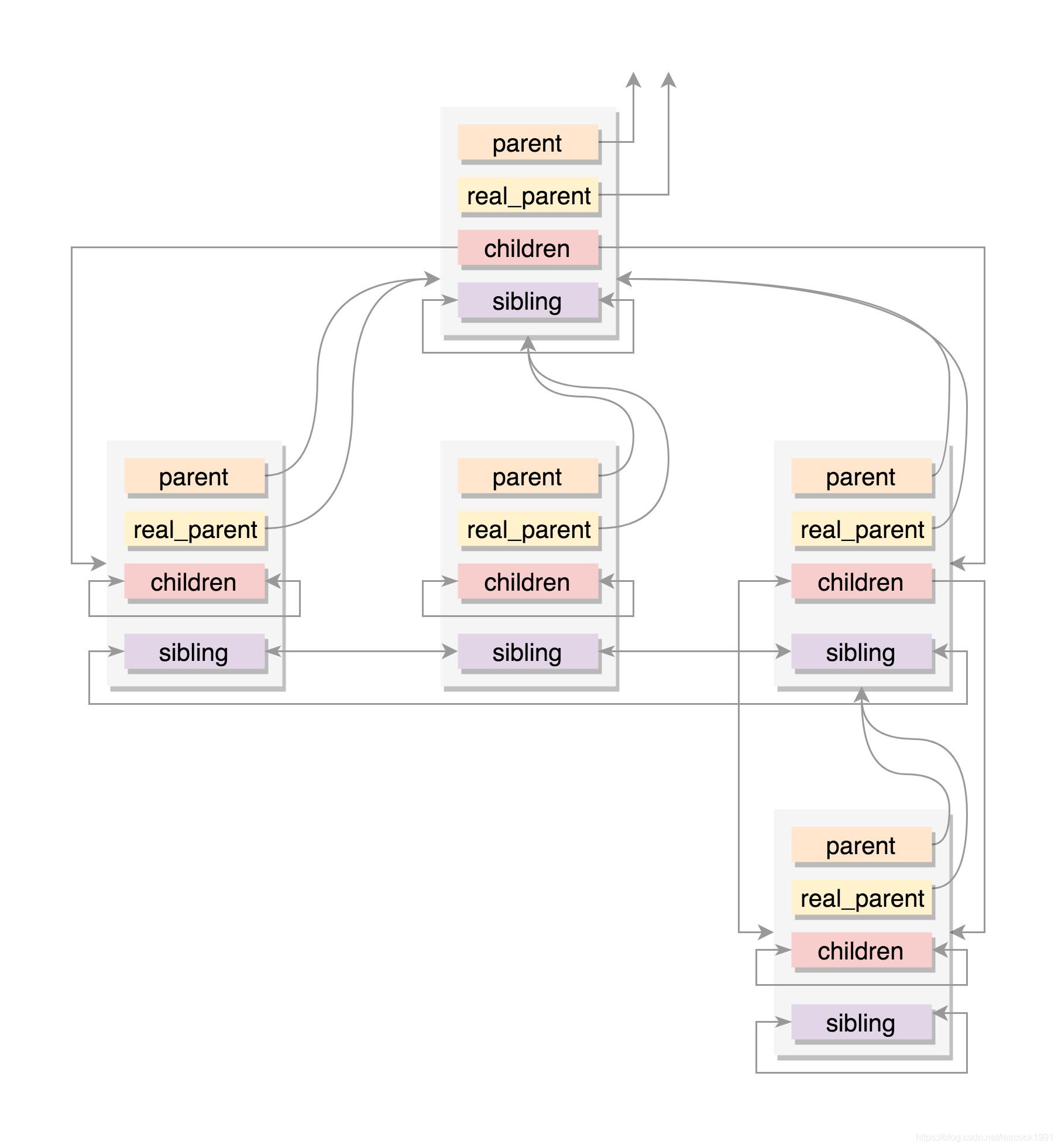task_struct 相关源码位置:
linux-4.13.16\include\linux\sched.h
运行统计信息
包含用户/内核态运行时间; 上/下文切换次数; 启动时间等;
u64 utime;//用户态消耗的CPU时间
u64 stime;//内核态消耗的CPU时间
unsigned long nvcsw;//自愿(voluntary)上下文切换计数
unsigned long nivcsw;//非自愿(involuntary)上下文切换计数
u64 start_time;//进程启动时间,不包含睡眠时间
u64 real_start_time;//进程启动时间,包含睡眠时间

进程亲缘关系
task_struct 里面关于进程亲缘关系的字段
struct task_struct __rcu *real_parent; /* real parent process */
struct task_struct __rcu *parent; /* recipient of SIGCHLD, wait4() reports */
struct list_head children; /* list of my children */
struct list_head sibling; /* linkage in my parent's children list */

- parent 指向其父进程。当它终止时,必须向它的父进程发送信号。
- children 表示链表的头部。链表中的所有元素都是它的子进程。
- sibling 用于把当前进程插入到兄弟链表中。
real_parent 和 parent 通常一样; 但在 bash 中用 GDB 调试程序时, GDB 是 parent, bash 是 real_parent

进程权限
task_struct 里面关于进程权限的字段
/* Objective and real subjective task credentials (COW): */
const struct cred __rcu *real_cred;
/* Effective (overridable) subjective task credentials (COW): */
const struct cred __rcu *cred;

real_cred 指针(谁能操作我这个进程); cred 指针(我这个进程能操作谁)
cred结构体
位置 /include/linux/cred.h
struct cred {
atomic_t usage;
#ifdef CONFIG_DEBUG_CREDENTIALS
atomic_t subscribers; /* number of processes subscribed */
void *put_addr;
unsigned magic;
#define CRED_MAGIC 0x43736564
#define CRED_MAGIC_DEAD 0x44656144
#endif
kuid_t uid; /* real UID of the task */
kgid_t gid; /* real GID of the task */
kuid_t suid; /* saved UID of the task */
kgid_t sgid; /* saved GID of the task */
kuid_t euid; /* effective UID of the task */
kgid_t egid; /* effective GID of the task */
kuid_t fsuid; /* UID for VFS ops */
kgid_t fsgid; /* GID for VFS ops */
unsigned securebits; /* SUID-less security management */
kernel_cap_t cap_inheritable; /* caps our children can inherit */
kernel_cap_t cap_permitted; /* caps we're permitted */
kernel_cap_t cap_effective; /* caps we can actually use */
kernel_cap_t cap_bset; /* capability bounding set */
kernel_cap_t cap_ambient; /* Ambient capability set */
#ifdef CONFIG_KEYS
unsigned char jit_keyring; /* default keyring to attach requested
* keys to */
struct key __rcu *session_keyring; /* keyring inherited over fork */
struct key *process_keyring; /* keyring private to this process */
struct key *thread_keyring; /* keyring private to this thread */
struct key *request_key_auth; /* assumed request_key authority */
#endif
#ifdef CONFIG_SECURITY
void *security; /* subjective LSM security */
#endif
struct user_struct *user; /* real user ID subscription */
struct user_namespace *user_ns; /* user_ns the caps and keyrings are relative to. */
struct group_info *group_info; /* supplementary groups for euid/fsgid */
struct rcu_head rcu; /* RCU deletion hook */
} __randomize_layout;

__rcu
RCU(Read-Copy Update),是 Linux 中比较重要的一种同步机制。顾名思义就是“读,拷贝更新”,再直白点是“随意读,但更新数据的时候,需要先复制一份副本,在副本上完成修改,再一次性地替换旧数据”。这是 Linux 内核实现的一种针对“读多写少”的共享数据的同步机制。
四个id组
- uid 和 gid
注释是 real user/group id
一般情况下,谁启动的进程,就是谁的 ID
权限审核的时候,往往不比较这两个 - euid 和 egid
注释是 effective user/group id
按照哪个用户审核权限
操作消息队列, 共享内存、信号量等对象 - fsuid 和 fsgid
注释是 VFS filesystem user/group id
对文件操作会审核的权限。 - suid 和 sgid
saved uid 和 save gid
由于suid和sgid保存了原始的用户id,可以随时使用 setuid,通过设置 uid 或者 suid 来改变权限。
一般说来,fsuid、euid,和 uid 是一样的,fsgid、egid,和 gid 也是一样的
特殊的情况

- 用户 A 想玩B 安装的游戏
游戏这个程序文件的权限为 rwxr–r–。A 是没有权限运行这个程序的,要用户 B 给用户 A 权限才行 - 开了权限后,A可以运行游戏了,但不能保存
当游戏运行起来之后,游戏进程的 uid、euid、fsuid 都是用户 A
保存这个文件的权限 rw-r–r--,只给用户 B 开了写入权限,,所以A写不进去 - 通过 chmod u+s program 命令,设置 set-user-ID 的标识位,把游戏的权限变成 rwsr-xr-x
用户 A 再启动这个游戏的时候,进程 uid 还是用户 A,由于有set-user-id 标识,euid 和 fsuid 就不是用户 A而是文件的所有者的 ID,也就是euid 和 fsuid 都改成用户 B 了
capabilities 机制
除了以用户和用户组控制权限,Linux 还有另一个机制就是 capabilities,用位图表示权限
capability 机制, 以细粒度赋予普通用户部分高权限
位置: \include\uapi\linux\capability.h
#define CAP_CHOWN 0
#define CAP_KILL 5
#define CAP_NET_BIND_SERVICE 10
#define CAP_NET_RAW 13
#define CAP_SYS_MODULE 16
#define CAP_SYS_RAWIO 17
#define CAP_SYS_BOOT 22
#define CAP_SYS_TIME 25
#define CAP_AUDIT_READ 37
#define CAP_LAST_CAP CAP_AUDIT_READ

- cap_permitted 表示进程能够使用的权限。但是真正起作用的是 cap_effective。
- cap_effective 实际起作用的权限, cap_permitted 范围可大于 cap_effective
- cap_inheritable 表示权限可被继承, 在 exec 执行时继承调用者的inheritable权限集合, 并加入到 permitted 集合,但在非 root 用户下执行 exec 时,通常不会保留 inheritable 集合
- cap_bset 系统中所有进程允许保留的权限,如果这个集合中不存在某个权限,那么系统中的所有进程都没有这个权限
- cap_ambient 当执行 exec 的时候,cap_ambient 会被添加到 cap_permitted 中,同时设置到 cap_effective 中,解决非 root 用户进程使用 exec 执行一个程序的时候,如何保留权限的问题
内存管理
数据结构 mm_struct
struct mm_struct *mm;
struct mm_struct *active_mm;

文件与文件系统
每个进程有一个文件系统的数据结构,还有一个打开文件的数据结构
/* Filesystem information: */
struct fs_struct *fs;
/* Open file information: */
struct files_struct *files;

task_struct 数据结构

参考资料:
趣谈Linux操作系统(极客时间)链接:
http://gk.link/a/10iXZ
欢迎大家来一起交流学习
























 853
853











 被折叠的 条评论
为什么被折叠?
被折叠的 条评论
为什么被折叠?










